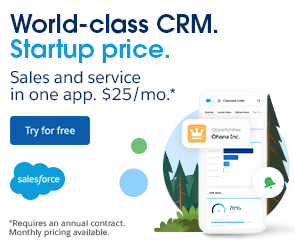Learn the differences between leads, prospects, and opportunities. Understand how to turn leads into prospects and opportunities.
Selling Signals content and product recommendations are editorially independent. We may make money when you click on links to our partners. Learn More.
Business networking is an effective method for finding high-quality leads and building relationships with people who can introduce you to potential customers in their network. Solid networking takes some preparation, strong people skills, and strategic follow-up. We spoke with sales experts and compiled the most impactful networking tips below so you can improve at this vital sales skill.
Before attending a business networking event, there are some preparatory steps you should take to ensure you make the most of your time there with potential leads. Check out these expert tips on choosing the right events to attend, picking your networking goal, forming a list of people you want to meet, and connecting with potential leads before the event.

Alex Hill
Sales Director, SEO Works
To use your time wisely, select events that attract people who fit your buyer persona and that allow adequate time for mingling (e.g., trade shows, industry conferences, local meetups). Director of sales Alex Hill says that you should especially join relevant networking groups:
“Find an established group with regular attendees who can vouch for the success being in the group has brought them, be that commercial or social, and always aim for a long-term view of gaining success from them. Don't see networking groups as a route to gain business solely for yourself and not put/offer anything in return. Be as sure as you can about your own network and own client roster or personal 'black book' and be ready to make the right sorts of introductions when appropriate.”
— Alex Hill, Sales Director, SEO Works
For example, you might join a business owners group where you can meet people who need your service or, at the very least, can introduce you to one of their clients who might benefit from your help. And you can help others get new business too so they're motivated to help you in the future.

Alex Melen
Co-Founder, SmartSites
Having a concrete goal for a networking event will enable you to craft a plan and elevator pitch that facilitates that desired result. Co-founder Alex Melen shares a few potential goals and recommends crafting an elevator pitch as well:
“Before attending an event, have a goal in mind. Are you looking to promote your brand? Are you looking for a business partner? Are you looking for a mentor or to become one? Once you have a goal in mind, prepare an elevator pitch. Rehearse what it is that you’re going to communicate to others to make sure you have it down to a succinct few sentences.”
— Alex Melen, Co-Founder, SmartSites
To craft an elevator pitch, write a few sentences that explain a few big customer pain points, how the product or service solves it, and how this benefits your customers. Read our article on creating an elevator pitch to learn more.

Erin Stone
Head of Sales, Hinterland Co
Creating a list of attendees who fit your buyer persona will enable you to go into the event with intention. You'll know exactly who you want to approach and start conversations with. Head of sales Erin Stone elaborates on this point and shares how to figure out who’s going to the events:
“When you attend a networking event with the hope of increasing sales, know who you want to target. If there's a list available online of attendees, check it out and investigate. If there's not, request one from the event organizer.”
— Erin Stone, Head of Sales, Hinterland Co
Once you have the list of attendees, find 5-10 that fit your buyer persona and then research their interests, job responsibilities, and other info you can use as a starting point for conversation. If you have a mobile CRM, record the information there, but you could also just use the notes section of your phone.

Ben Lamarche
General Manager, Lock Search Group
It’s a good idea to get on the radar of the people on your target list before a networking event. General manager Ben Lamarche says a simple pre-event Twitter follow can do the trick:
“Connecting with people on your list and other attendees on Twitter shortly before the start of the conference or a particular session can help break the ice and allow you to walk away from the conference having networked with your targeted contacts plus others whom you didn't anticipate.”
— Ben Lamarche, General Manager, Lock Search Group
If anything, this will help the person recognize you. You could even go a step further and send emails to the best potential leads, giving the location of your booth and asking them to stop by for a quick personal demo or presentation.
There are specific ways to act while at your networking events. These include meeting everyone, going off on your own, encouraging your new contacts to talk about themselves, and listening carefully. If you follow these basic best practices, you’ll optimize your lead generation process and win over more friends at both recreational and professional events.

Todd Ramlin
Manager, Cable Compare
One of the best ways to make people like you is to facilitate conversations that revolve around them and their interests. Ask questions about what they’re doing currently, or about their future plans for their business. As manager Todd Ramlin says, this will cause them to open up to you:
“One of my favorite general tips for networking is to get the other person talking about themselves first. By listening to the other person before speaking, you can use what they tell you to personalize your pitch to them based on what they say.”
— Todd Ramlin, Manager, Cable Compare
When you learn about their plans, needs, and pain points, you can focus your elevator pitch on helping them get what they want so your business offering is more interesting to them. They’ll also be obliged by social norms to ask more about your product or service since you asked about them.

Sophie Chiche
Founder & CEO, becurrent
Always be on the lookout for potential business connections, even when you’re at a recreational event or spending time with friends. CEO Sophie Chiche explains why this hyper-awareness can be so beneficial to your sales numbers:
“Whether you’re having a conversation with friends, getting a drink with some business associates, or just schmoozing with some friends at the gym, listen for any sign of a business opportunity. Maybe someone mentions a cousin who just started a new business. Maybe someone mentions a business associate who is struggling in an area in which your business can help them. People are actually telling you all the time about new business leads if you listen and read between the lines a little bit.”
— Sophie Chiche, Founder & CEO, becurrent
When a potential lead feels heard and understood, they’ll be more likely to want to work with you. Try the mirroring technique: repeat the last few words of their statement in a questioning tone. This can also encourage them to elaborate, cluing you in to issues they need your help solving.

Paige Arnof-Fenn
Founder & CEO, Mavens & Moguls
Many conferences, both online and in-person, have speakers that can go anywhere from 5-30 minutes. This is a great chance to build your reputation as an expert. CEO Paige Arnof-Fenn describes why public speaking is so effective for business networking:
“I am a fan of public speaking to raise my profile, build my pipeline, and increase my credibility. I like speaking to groups (now online mostly), have a lot of topics I can talk about, and find it is a great way to build my brand and grow my business. It adds instant credibility to me as an expert and thought leader in my field too. I have gotten media coverage and quoted as an expert, and it has led to other speaking engagements and allowed me to raise my prices as a known expert with higher Google rankings.”
— Paige Arnof-Fenn, Founder & CEO, Mavens & Moguls
One of the best outcomes of public speaking at business networking events is that you’ll have plenty to talk about during the mingling period. People will ask more about the topic you discussed. Plus, potential clients will likely initiate a conversation with you, the expert, instead of the reverse.
The sales experts we spoke with recommend following these best practices to make the best impression on potential leads during virtual networking: decorate your office as a background on your calls, connect with attendees on social media, and take advantage of breakout sessions.

George Nguyen
Editor, Third Door Media
During virtual conferences, meetups, or video calls, use your space to your advantage by decorating it with material that could spark conversation and connection. Editor George Nguyen further explains this tactic:
“Instead of opting for a sterile home office setup as a backdrop, or a green screen-type background, I recommend decorating your space to leave an impression. You can use swag from your own brand or just go with items that might make for good talking points. Anything that people can bond with you over will increase the odds that they're willing to talk to you again later.”
— George Nguyen, Editor, Third Door Media
Whether it’s sports memorabilia or a painting hanging on the wall, it opens up avenues for conversation. Once you’ve engendered a comment like “a Yankees fan, eh?” an instant connection — built upon either teasing or mutual fandom — is around the corner.

Chris Gadek
VP of Growth, AdQuick
Many virtual conferences and trade shows have live chat features that can help you find people who might need your product or service. Vice president of growth Chris Gadek explains his strategy for optimizing connection rates during virtual networking events:
“I always have a goal beforehand of whom I'm looking to meet to avoid wasting my time or anyone else's. And when I have the opportunity to introduce myself on the chat, I provide a quick intro along with my LinkedIn URL. And I keep my social channels open so that I can respond instantly to connection requests. Virtual events have a more relaxed atmosphere than in-person gatherings, making meeting the right people even easier.”
— Chris Gadek, VP of Growth, AdQuick
This way, you’ll have countless new leads requesting connections on social channels. You can then respond and even invite them to chat offline or in a breakout room at the live event if they seem like a good fit.

Pam Hill
Founder & Managing Director, My Smart Cousin
For online meetups, webinars, or virtual conferences, try logging on early so that you’re prepared to meet everyone that enters. Managing director Pam Hill shares her process for succeeding in virtual meetups:
“For online meetups, log in a couple minutes early, follow up your introduction with a chat to everyone on the call giving your company name and details, send private chats to folks you’d like to connect with, and conclude with more in-depth conversations with targeted folks in the breakout rooms.”
— Pam Hill, Founder & Managing Director, My Smart Cousin
In those breakout sessions, start a conversation with lessons learned during the presentation or questions you have for members in the group regarding their experience at the event. You could also bring up industry news and trends related to the presentation to show off your industry acumen and knowledge.
In-person events like industry conferences, local meetups, and trade shows are valuable opportunities to form deep connections with a wide range of potential customers. To succeed at these events, our panel recommends making yourself approachable, bringing business cards, chatting up people who are alone, and going alone yourself.

Lattice Hudson
Business Coach & Founder, Lattice & Co
At in-person events, it's important to seem approachable to fellow attendees. Nothing does this more effectively than a warm smile. Business coach Lattice Hudson reminds us of the power of friendliness and genuine interest:
“During events meant to network your brand, it's easy to forget to smile. Wearing your best smile during an event will make you look friendly and easy to converse with during sessions. Another tactic I like to utilize is not overusing questions. Instead, I like to take people's answers and dig deeper into their responses to discover and establish a stronger professional relationship while networking.”
— Lattice Hudson, Business Coach & Founder, Lattice & Co
For example, perhaps a lead says they’re in charge of managing a sales team of 20. Instead of changing the subject by asking them your next prepared question, dig deeper and ask them the challenges of managing such a large sales squad.

Andrew Taylor
Director, Net Lawman
Bring your business cards to the event and hand them out to people you meet at the end of a conversation if they seem like a good fit. Though they might seem a bit old fashioned, director Andrew Taylor says they’re still as effective as ever:
“Bring plenty of business cards, even if you don't think you'll use them all. But don't just hand them to everyone you meet at once; it won't get you anywhere. Instead, talk with people, and when exiting the conversation leave a few business cards. There’s a high chance these people will remember you and stay in contact with you.”
— Andrew Taylor, Director, Net Lawman
There’s something pleasant and personal about receiving a business card from someone you just met. Plus, if the person should need a service like yours, they can instantly find how to reach you. If you lack a business card, create one for free using a design tool like Adobe.

Rich Rudzinski
Founder, Drivey
Taking initiative is essential if you want to leave an event with a healthy list of potential clients. If you’re unsure about who will be easy to start a conversation with, business founder Rich Rudzinski has you covered:
“Networking is an important part of being an entrepreneur; however, it's not always easy. It can be awkward to be at a networking event where everyone is hovering above the hors d'oeuvres or clutching their cocktails. My number one tip is, as silly as it sounds, to start conversations. I usually try to approach the people who are by themselves, as sometimes these people are shy and just need a push! I have gotten to meet amazing people by doing this, and this has also led to great business opportunities.”
— Rich Rudzinski, Founder, Drivey
While it can be hard to break into group conversations, it's easy to strike one up with a lone wolf, and they’ll be happy you’ve given them someone to talk with. Bring up the venue’s lunch or presentation to kick things off.

Lori Cheek
Founder & CEO, Cheekd
Though it’s important to have a list of potential leads to target at business networking events, it’s also important to avoid dismissing someone off the bat. Sales opportunities sometimes hide in the unlikeliest of places. CEO Lori Cheek explains her strategy for succeeding at networking events:
“The most important lesson I've learned in networking (which I'd wish I'd known years ago) is to take every advantage possible to meet new people — efficiently communicating and never dismissing a single soul. You never know who you're talking to, who they might know, or how they'd be able to contribute. When attending networking events, I find that it’s most advantageous to go alone so that you’re forced to talk to new people.”
— Lori Cheek, Founder & CEO, Cheekd
Without a friend or colleague as a crutch to rely on for conversation, you’re either stuck standing in the corner scrolling on your phone or out there initiating conversations and getting to know potential buyers. It’s a good way to force yourself to do the scarier thing.
If you fail to follow up with potential leads you meet at an event, you risk falling off their radar or killing any momentum you’ve created around a deal or relationship. The sales experts we asked about networking recommend connecting instantly on LinkedIn, sending a follow-up email a few days later, and making rapport-building phone calls regularly.

Samantha McKenna
Founder, #samsales Consulting
After you meet someone who represents a business opportunity, connect with them on LinkedIn. This will solidify the relationship. #samsales Consulting Founder Samantha McKenna elaborates on this point:
"The biggest missed opportunity I see in networking is building a process around connecting on LinkedIn afterward. If I meet a new connection — either in-person or virtually — I'll immediately follow that meeting with a connection request and a personal message. Not only will this help me build my network more steadily, but I'll always have that personal message as my trick to remember how we met."
— Samantha McKenna, Founder, #samsales Consulting
The LinkedIn connection message can be short and sweet. For example, you might write “Great talking with you about {topic} at {event}.” Anything personal that fastens you to their memory will suffice.

Adelle Archer
CEO & Co-Founder, Eterneva
Within a few days after meeting a lead, send them an email reminding them of yourself, your business, and your conversation. This is a great way to start growing this new relationship. CEO Adelle Archer shares what to include in your emails and why this is an important step in networking:
“Sending personal notes that highlight parts of your conversation, reference aspects of their business, and mention characteristics of your business that they showed interest in are ways to demonstrate your attention to detail and form a human connection. By customizing your communication to each networking opportunity, you will set a better foundation for them to get back to you.”
— Adelle Archer, CEO & Co-Founder, Eterneva
If the person showed interest in your solution, take this chance while you’re still fresh in their memory to ask for a meeting, whether it be a more in-depth discovery call or product demo. If the person didn’t seem interested but fits your buyer persona, simply end by telling them you’re around if they need any help.

Kathleen Ahmmed
Co-Founder, USCarJunker
Consider calling people you meet at events just to catch up and see how they’re doing, especially if you really hit it off with them at the event. Business co-founder Kathleen Ahmmed explains why rapport-building calls are so beneficial:
“One of the best tips that I would suggest is to surprise the people in your network by making rapport-building phone calls just to see how they're doing. You can ask them about their families, how work is going, how their favorite sports teams are doing, what hobbies they are into lately, etc. The idea is to ask about anything that shows an interest in them as people because you can often build strong relationships just by taking a few minutes of your day to catch up, which could end up making a big difference in your future success.”
— Kathleen Ahmmed, Co-Founder, USCarJunker
The most advantageous aspect of making calls without salesy intentions is that one day, when the lead does need someone to handle the problem you solve, you’ll be top of mind. They’ll be more likely to reach out to you and will already trust you so much that the deal should close rather quickly.
Social networks such as LinkedIn provide a wonderful space to build your reputation as an expert in your industry, expand your network, and engage with potential buyers. The sales experts we talked to recommended some great techniques to use so you can come across as a value provider online and get more connections.

Chris Kelleher
Enterprise Sales Leader, Modern Health
Pinging your current online network connections for introductions is a great way to get in front of potential clients. Enterprise sales leader Chris Kelleher talks about how to ask your network for virtual introductions:
“The best chance of success comes from networking through a second-degree connection to get to your targets. When leveraging your connections, keep your ask very simple and easy for your connections to copy and paste and top and tail a message to your targets. You just want an intro, and your note should have enough of a high-level value story — of course, personalized to the company and individual — to attract interest from your targets through your mutual connections. Couple this approach with a strong brand presence on LinkedIn. Your chance of successfully networking directly or through connections increases 3x if you have a great profile, post engaging content, and come across as someone who people want to meet and do business with.”
— Chris Kelleher, Enterprise Sales Leader, Modern Health
Chris told us that his C-level executive contacts are far more likely to respond to requests to speak to a salesperson that come through someone they know compared to cold outreach. He stressed that sellers should dedicate more time to doing networking right than crafting cold emails to C-level execs.

Richard Harris
Founder, The Harris Consulting Group
When you send a connection request to a decision maker on LinkedIn, make it about them, not yourself. The well-known sales expert Richard Harris lists off some other common mistakes people make when using LinkedIn for connecting with potential leads:
“The biggest mistakes when connecting on LinkedIn are the following: 1) sending a connection request with no relevance, 2) sending a connection request with a generic ‘we have mutual connections,’ 3) sending a connection request with a pitch, 4) sending a connection request to 'pick your brain' or 'discuss synergies.' All of these scream desperation and the receiver knows a pitch is coming. And ultimately, they are bad because they are all about you, the sender.”
— Richard Harris, Founder, The Harris Consulting Group
Instead of making these mistakes, try to include something valuable in the request, such as an informative piece of content or a news article they might like. The next tip expounds on how to do this effectively.

Dan Gower
Owner, Buddy Gardner Advertising
Giving someone a reason to connect with you is one of the most critical parts of LinkedIn networking. Business owner Dan Gower gives a way to phrase the reason you’re connecting with the decision maker so they’re most likely to accept:
“Try something like, ‘I see that we're both members of X group or attended Y conference, so I thought you might also be interested in this resource.’ Then share a valuable blog post or guide that might actually be helpful to me. It's a better way to nurture a lead than hitting my inbox with some bland introduction before sending me a sales pitch in your very next message.”
— Dan Gower, Owner, Buddy Gardner Advertising
After they agree to connect, continue sending them content about the industry that they might enjoy. And interact with them on the network by commenting on their posts or sharing articles they’d like. After the relationship is warmed up — say after a few weeks — you can ask for a meeting.

Mike Sheety
Owner, That Shirt
In online communities like LinkedIn groups, it's crucial that you give a little to it each day and to ask specific members for time to talk one on one over a video call or a cup of coffee. Business founder Mike Sheety explains how to interact with the community on a consistent basis:
“To network successfully while limited to online meetups, I'd recommend being particularly active and engaged with the community. This means answering and asking questions, sharing experience and ideas, but also calling to action anyone interested to meet up and discuss in more detail the shared ideas.”
— Mike Sheety, Owner, That Shirt
When you regularly share ideas and insights with members and help others get answers to questions, you’ll grow your reputation as a thought leader in the group, meaning more people in the group will look to you and your business for assistance.
Business networking is a great addition to any lead generation plan. It enables you to form connections with various people who can either buy your solution or introduce you to someone who could benefit from it. A diverse business networking strategy involving in-person events, virtual conferences, and social networks like LinkedIn will expand your reach and increase your likelihood of finding potential buyers.
Check out our recent and related articles on the topic
Learn the differences between leads, prospects, and opportunities. Understand how to turn leads into prospects and opportunities.
Lead generation is an important part of any successful sales strategy. Check out these 52 lead generation statistics to help you get ahead.
Email nurture campaigns are an effective way to engage leads. Learn sales experts' 14 best practices for successful email nurture campaigns.
Looking for the best lead generation companies for prospects? Explore the top seven lead gen companies and learn how they generate leads.
Lead scoring is essential for driving effective marketing efforts. Use our lead scoring template to support your goals.
B2B lead generation helps you identify, target, and qualify prospects. Learn the process, tools, and benefits for inbound and outbound success.
Learn the strategies for generating PPC leads. Discover the best practices for successful lead generation campaigns.
Lead nurturing is essential to customer success. Check out the top six strategies to help drive conversions and get more qualified leads in 2024.
Finding the right decision-makers in a company can be a challenge. Learn how to identify and reach out to the right people in an organization.

